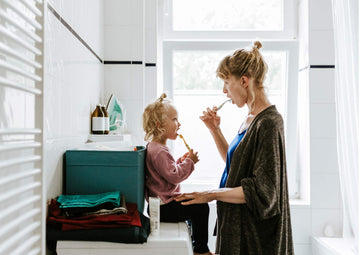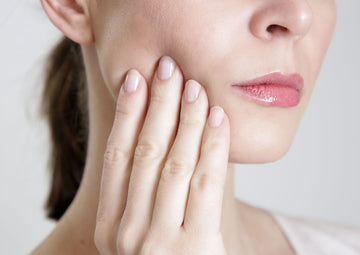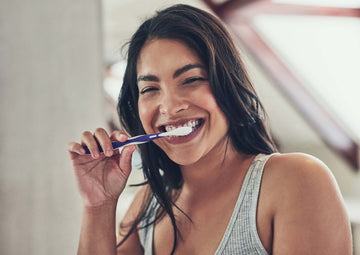5 Dental Health Printable Activities to Teach Kids About Oral Hygiene
by Aura Glow on Mar 01, 2021


Teaching your children healthy oral hygiene habits from a young age is key in protecting their teeth for years to come. Since there are so many benefits of sharing a smile, ensuring your child’s teeth are healthy is one way you can help to boost their confidence. While brushing and flossing isn’t always the most exciting activity for kids, there are plenty of ways you can make it fun.
3 Oral Hygiene Habits to Start Early

As a parent, it’s important to teach your child proper brushing and flossing routines. It might not be their favorite activity, but like bathing and washing their hands, it’s an essential part of taking care of themselves. Here are three oral hygiene habits that will set your child up with a healthy mouth for life.
1. Proper Brushing and Flossing
The key component to healthy teeth is regular brushing and flossing habits. It’s important to slowly transition from brushing your child’s teeth for them to letting them own the task. This will ensure they know the proper techniques and aren’t using too much toothpaste. Once your child is 6 or 7, they should also be flossing their teeth daily.
When you begin teaching your child about brushing, keep in mind these brushing tips from the American Dental Association:
- Position the tooth brush at a 45-degree angle to the gums.
- Gently move the brush back and forth in short (tooth-wide) movements.
- Brush the outer, inner, and tops of the teeth.
- When cleaning the inner surfaces of your teeth, tilt the brush vertically and make several up and down motions.
2. Healthy Eating Habits
Many foods that your child will consume include some type of sugar, which can lead to tooth decay. To help cut down on unnecessary sugar, check the labels and choose foods and beverages that are low in sugar. Also watch out for foods that can stain teeth like cranberry juice, beets, and hard candies.
3. Discouraging Nail-Biting and Using Teeth as Tools
Nail-biting and using teeth as tools can lead to a variety of complications that include wear and tear on the teeth, gingivitis, and bruxism, which is a teeth-grinding habit. A few things you can do to discourage this is to keep your child’s nails short and replace nail-biting with a healthier habit like squeezing a stress ball.
5 Dental Health Printables to Make Brushing Fun
Whether it’s the extra step before starting their day or that it’s not an optional task, many kids tend to dislike brushing their teeth. But whether they like it or not, teeth brushing is an essential part of keeping their mouth and teeth healthy for life.
From introducing a tooth brushing puppet to tracking each new and lost tooth, here are 10 ways you can make oral hygiene enjoyable for everyone involved.
1. Track Teeth Brushing
One easy way to make teeth brushing a regular part of your child’s routine is to introduce a teeth brushing tracker. Have your child mark off their morning and evening brushes.
You can also introduce weekly rewards like an extra bedtime story or a trip to the park if they don’t miss any of their weekly brushes. Keep this in the bathroom and use magnets or an erasable marker so you can re-use it.

2. Add Stickers to Their Bathroom Mirror
Help your child remember to brush their teeth by adding a few fun stickers to their bathroom mirror.

3. Leave a Receipt for the Tooth Fairy
Once your child begins to lose their teeth, introduce a fun tradition of the tooth fairy leaving behind a receipt after taking your child’s tooth.


4. Keep Track of New and Lost Teeth
Keep track of how many teeth your child has lost and new teeth coming in by starting a smile tracker. This can also be a good opportunity to teach your child about baby teeth and permanent teeth.

5. Get Colorful
Let your child get creative with a dental hygiene-related coloring page that you can hang up in the bathroom for tooth brushing inspiration.


Additional Ways to Keep the Conversation Going

Continue dental health education beyond the sink by talking about the benefits of healthy teeth whenever you can. You can do this by talking about different foods that are good for teeth or by reading a book about healthy smiles together.
Read A Book Together
There are many cute dental hygiene-related picture books to choose from, and many of your child’s favorite characters will have their own stories about brushing. Pick out a few books and read them together after their nightly brushing.
Make a Brushing Playlist
Since the American Dental Association recommends brushing for two minutes twice a day. Pick out a variety of songs that last for two minutes (or close to two minutes) to play as your child brushes. Adding tunes to their routine is a fun way to make the time fly as they brush.
Choose a Special Toothbrush
You could also make things a little more fun with your child by going shopping together for a special toothbrush. Let them choose one with their favorite color or their favorite character to make brushing even more fun.
Age-Appropriate Toothbrushing

Cavities are one of the most common chronic diseases among children in the United States. Luckily, cavities are preventable by introducing healthy brushing and flossing habits. Here’s how you can ensure your child is keeping on top of their oral hygiene from the very beginning.
Newborn–3 Years Old
From the time your child is born there are a few things you can do to take care of their teeth. Wipe their gums twice a day with a soft cloth after the first feeding of the morning and right before bed to clean off the bacteria and sugars that can cause cavities. Once your child’s teeth start coming in, brush their teeth for them twice a day (morning and night) with a soft-bristled toothbrush and plain water.
Aim to make your child’s first dental appointment when the first tooth erupts in the mouth or no later than age one or two. These initial visits are a great way for your child to get to know the dentist, become familiar with some of the instruments that are used for cleaning and even take a ride in the dental chair.
After your child is comfortable in the dental office setting, then the dentist will be able to take a look inside your child’s mouth. This process helps to avoid any of the anxiety that can come with dental visits.
3–6 Years Old
Once your child turns three, this is when you can begin brushing their teeth for them. Ensure there’s only a pea-sized amount of toothpaste on the toothbrush and watch them spit out the toothpaste rather than swallow.
6 Years Old and Up
After they turn 6, you can let your child begin brushing their teeth on their own. We’d recommend brushing alongside your child in the beginning to make sure they’re still spitting out their toothpaste and brushing for the recommended two minutes in the morning and two minutes in the evening.







